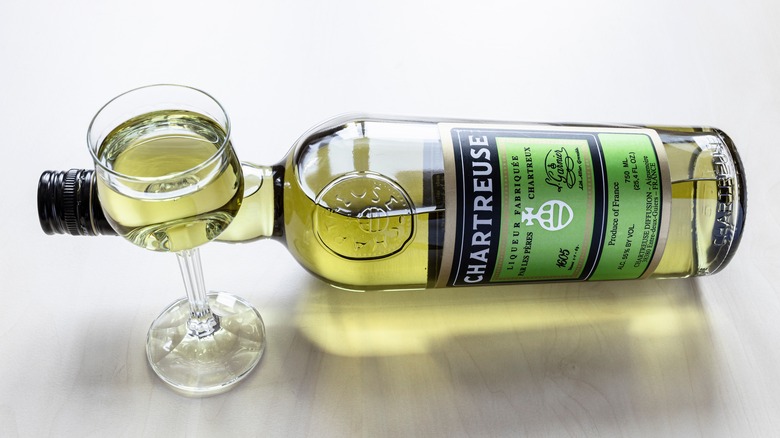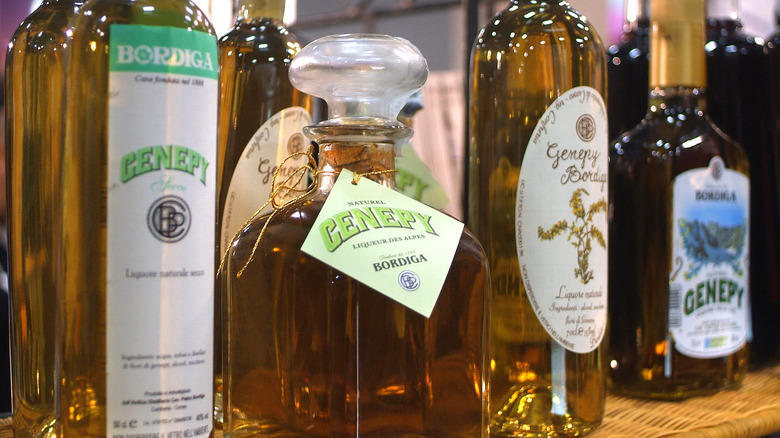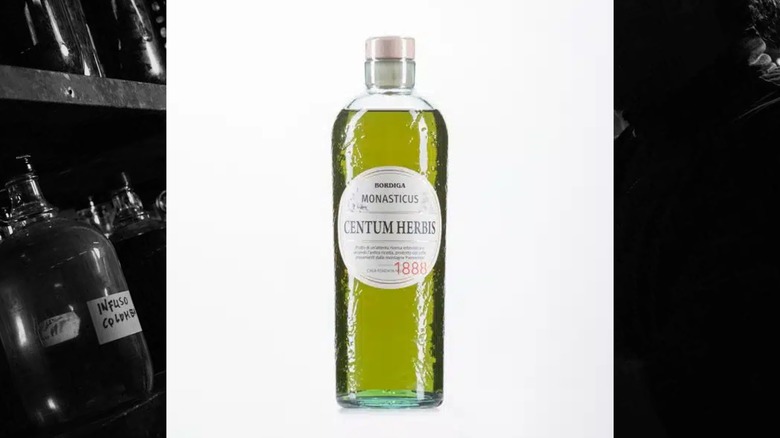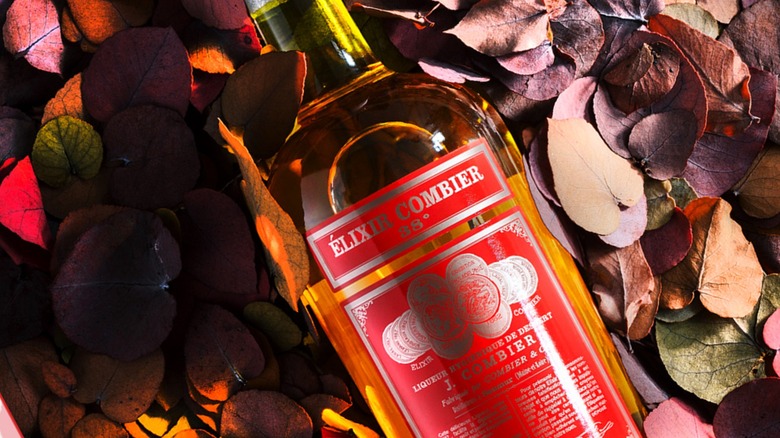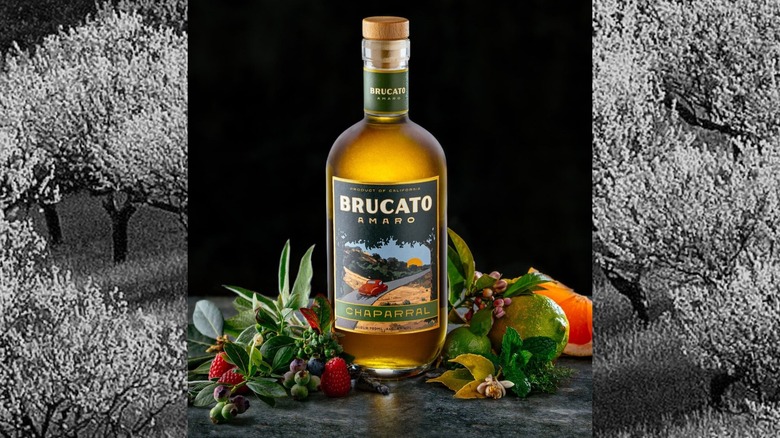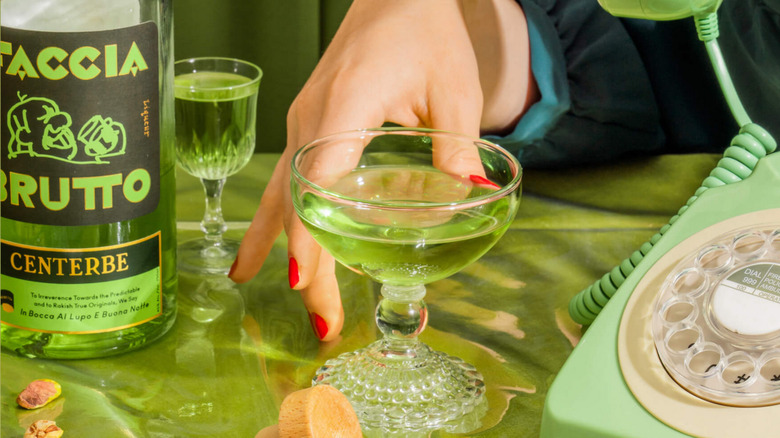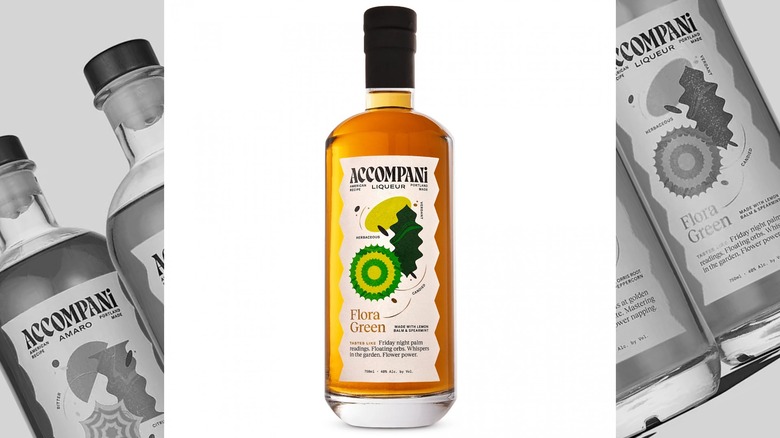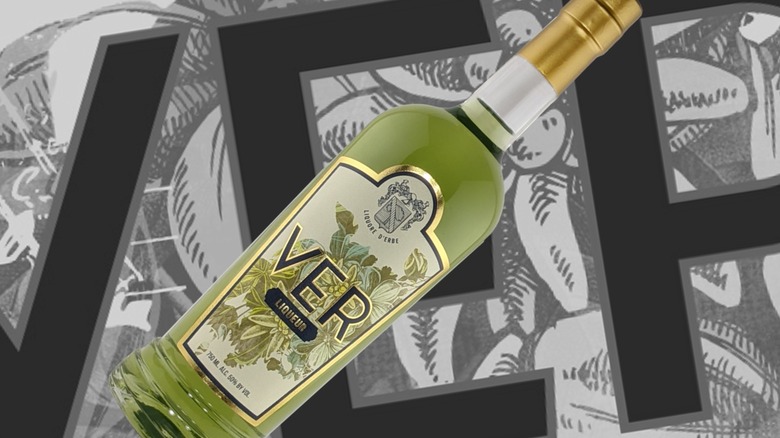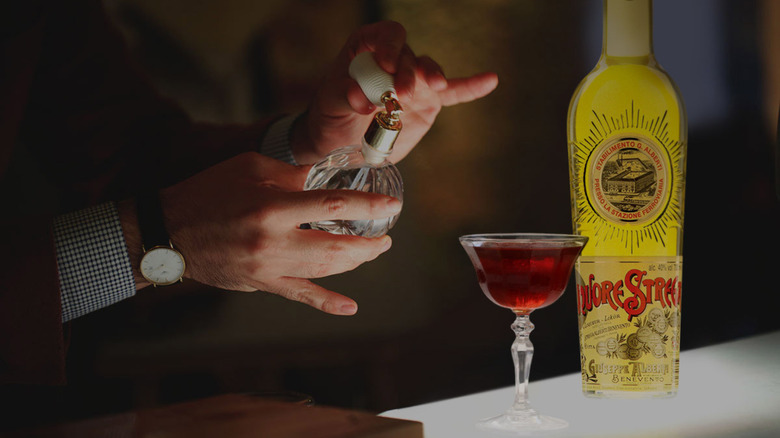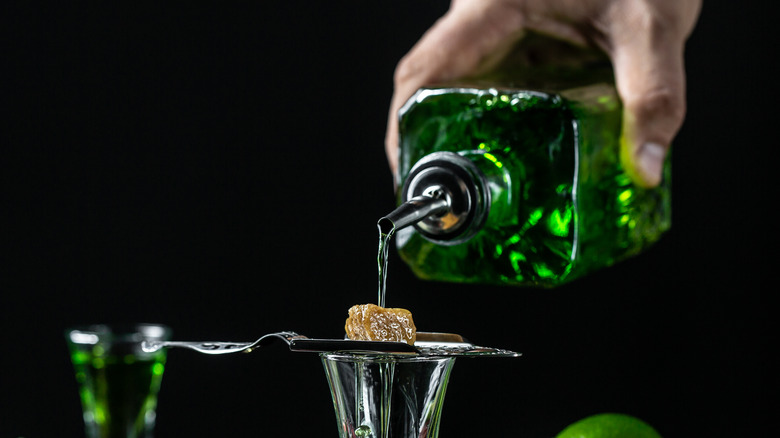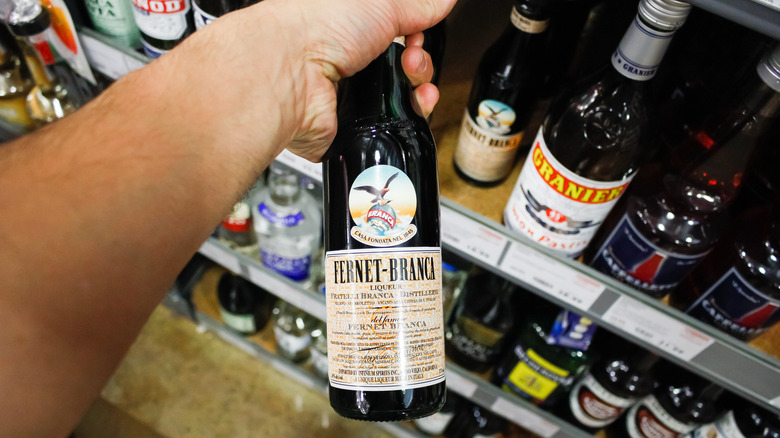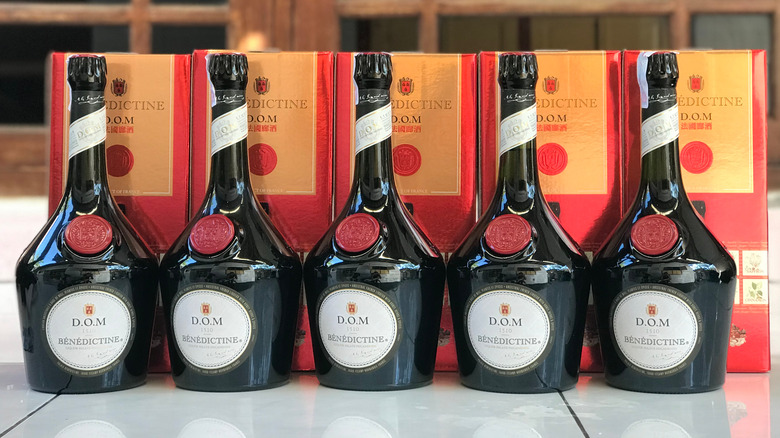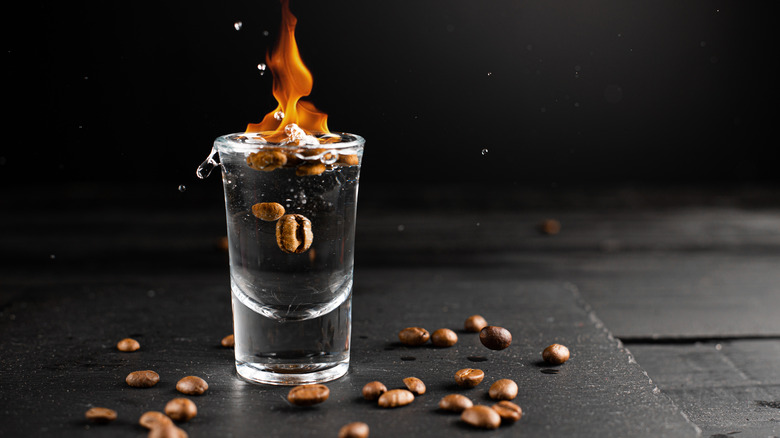The Best Chartreuse Alternatives To Combat The Liqueur's Shortage
Those familiar with the Chartreuse know it as a complex and intriguing liqueur, herbaceous and vegetal in taste with a unique historical significance. Despite its origins in the 16th century, the liqueur has become increasingly popular in recent years as a cocktail ingredient, and might now be considered a victim of its own success.
The history of Chartreuse is long and complicated but in brief, it was first created by French Carthusian monks following an alchemical manuscript claiming to contain a recipe for an "elixir of long life." Over the years, the monks were prosecuted and forced to flee the country with the manuscript secretly changing hands over time. Today, the liqueur is still made by the same order of monks back in France, with just two members of the order familiar with the secret formula which is said to contain around 130 herbs and botanicals. Herein lies our problem.
We need to remember that as monks, the producers of Chartreuse have commitments beyond creating delicious liqueurs for a global market, and so it's somewhat understandable that they've decided to cap production of both green and yellow Chartreuse and prioritize their religious commitments over meeting a surge in global demand. While this isn't great news for a cocktail industry that's become reliant on having a bottle of Chartreuse in their arsenal, fortunately, there are a number of excellent alternatives to choose from.
Génépi
While isn't directly comparable to Chartreuse, it shares more than a few tasting notes. The traditional herbal liqueur is made in the European Alps, in the same region in which Chartreuse is produced, so while the ingredients of the latter are a closely-guarded secret, the two almost certainly have a few in common.
The thing that sets génépi apart is that it's made by infusing the base spirit with flowers of the alpine plant, Artemisia genipi, giving it a refreshing floral bouquet with hints of chamomile and mint. The use of the Artemisia genus also puts it in the same family as absinthe, meaning some varieties boast a hint of anise. Génépi offers a slightly earthy taste, with a pleasant bitterness that lingers on the palate, and it has a sweetness that makes it an appropriate replacement for yellow Chartreuse, the lighter and less intense of the two varieties. Try using it as a substitute in classic Chartreuse cocktails like the yellow Chartreuse Swizzle where the milder profile is boosted by sweet pineapple juice and zesty Velvet Falernum.
Bordiga Centum Herbis
Centum Herbis — "a hundred herbs" in Latin — is an Italian herbal liqueur in the style of the traditional digestifs of the alpine area. Like génépi, the shared geography and culture of Centum Herbis means there's plenty of crossover with Chartreuse in terms of flavor.
Centum Herbis has an intense herbal aroma of mint, thyme, eucalyptus, with tasting notes that match the unique botanicals used in its production. Quassia bark, linden leaves, and juniper are just a few of the ingredients that shine through the grassy liqueur which has a balanced bitterness but packs a punch on par with Chartreuse.
The Italian liqueur has a subtle sweetness but its deep complexity means it's better as a substitute for green Chartreuse, the bolder and more pungent of the two styles. The Last Word is likely the most famous of the Chartreuse-based cocktails and would probably be the most sorely missed when stocks dry up; luckily, Centum Herbis is robust yet balanced enough to make a worthy substitute.
Élicser Combier
Elixir Combier is a French herbal liqueur produced in the traditional style with a secret blend of spices, roots, and botanicals. Inspired by a 19th-century recipe for a "hygienic dessert liqueur" by one Doctor Raspail, Combier produced the Elixir from 1852 until 1980 before it was discontinued.
Thankfully, as more bartenders began using herbaceous European liqueurs ubiquitously in their creations, Combier decided to revive the original Elixir in 2011. While we certainly won't claim the Elixir has any medical benefits, something that was easier to get away with 150 years ago, we can discuss its delicious flavor profile. The aroma is a harmonious balance of the drink's herbal and floral elements, including anise, citrus peel, and coriander. Meanwhile, its taste is herbaceous and moderately sweet, with a touch of cardamom and clove spice and a pleasantly lingering aftertaste.
As a substitute, Elixir works best as a replacement for yellow Chartreuse, particularly in the classic Bijou where it accentuates the botanical complexity of the gin and vermouth-based drink while adding a subtle spiciness to the drink.
Brucato Chaparral
Despite the Italian-sounding name, Brucato is an award-winning Californian-based producer of amari, a bitter Italian herbal digestivo that was also once heralded for its supposed medical benefits. However, while Brucato's amari share much with their Italian ancestors, they're unique in their use of locally-sourced American-grown ingredients, such as yerba santa, spearmint, and cardamom.
Brucato makes a range of amari, but the offering that most closely resembles Chartreuse would be Brucato Chaparral, which takes its name from California's chaparral shrubland region. The aroma is rich and fragrant, with prominent notes of sage, lavender, and cardamom, and it has a bright herbal taste with a bitterness that isn't overpowering.
Brucato Chaparral is comparable to green Chartreuse thanks to its pronounced herbal qualities, and the distiller themselves recommend using it as a substitute in The Last Word or Bijou cocktails. They also have a few cocktail suggestions of their own, such as the Fernwood, which uses a touch of Chaparral to enhance the complex spice and honey notes of reposado tequila and the dry herbaceousness of blanc vermouth.
Faccia Brutto Centerbe
Centerbe is a style of Italian liqueur from Abruzzo, whose name — like Centum Herbis — means "100 herbs," albeit in the Italian language this time, as opposed to Latin. However, rather than being produced in Italy, Faccia Brutto is actually a Brooklyn-based distillery and, despite the name, their version of Centerbe contains just twenty botanicals.
Known for their organic digestivos and aperitivos, Faccia Brutto is the brainchild of the former executive chef of the top Brooklyn restaurant, Rucola, so you can expect a liqueur that's both innovative and authentic. While its light green hue is certainly reminiscent of Chartreuse, the lower amount of ingredients means Faccia Brutto Centerbe isn't as syrupy as the original, and it's more bittersweet.
Boasting a captivating list of botanicals such as lemon balm, anise hyssop, nettles, and coriander, and a unique flavor profile, Faccia Brutto Centerbe works best as an alternative to yellow Chartreuse. Its lower intensity makes it the perfect substitute ingredient for a Yellow Smash cocktail, but it also stands on its own legs and can be used to add a spicier and more herbal profile to classic cocktails, like a gimlet.
Glep Amaro di Erbe Grinta
While Italian distiller Glep may be more well-known thanks to their award-winning gin, they have a tight yet superb range of authentic Italian liqueurs, including a sweet and dry vermouth and, of course, an amaro. While not all amari are suitable replacements for Chartreuse, Amara di Erbe Grinta definitely meets the criteria.
Made with a delightful mix of botanicals, including rhubarb and gentian, Amara di Erbe Grinta is bolstered with plenty of aromatic herbs from the Piedmontese Alps, giving it a deep earthy, herbal aroma. It has a slightly sweet and pleasantly bitter taste with a touch of balsamic on the palate and, like most amari, it's designed for sipping after a hearty meal.
Amara di Erbe Grinta's bold flavor profile makes it a solid alternative for green Chartreuse; however, it's also worth experimenting with it as a substitute ingredient for other bitter cocktail components. For example, try using it as a replacement for Campari in a Bitter French — a cocktail that can be described as halfway between a French 75 and a Negroni — to let the tangy rhubarb really shine through.
Accompani Flora Green
Hailing from Portland, Oregon, Accompani is the name Straightaway Cocktails — a producer of ready-to-drink bottle cocktails — gives to their bespoke line of liqueurs, vermouths, and amari. While their whole range is certainly worth exploring, the multi-award-winning Flora Green is the liqueur of choice for anyone looking for a suitable alternative to Chartreuse.
Bright and herbaceous, Accompani Flora Green uses Mediterranean ingredients like hyssop, chamomile, and lemon balm to create a liqueur with a distinctive alpine character that could have come straight out of Europe. Its aroma contains notes of citrus zest, oregano, and thyme, while on the palate, it offers a fresh and mildly sweet taste, followed by a gentle bitterness and a long-lasting herbal aftertaste.
Flora Green is a little too overpowering to replace yellow Chartreuse, but it makes an excellent alternative to the green style. Try using it in a twist on a Herbal Martini, ramping up the botanical flavors with gin and extra dry vermouth, and bolstering the zestiness with a touch of limoncello for a lighter, Mediterranean twist on one of the classics.
Ver
The name Ver translates to "wormwood" in French, paying homage to the historical significance of the perennial herb in traditional herbal liqueurs and spirits. The use of wormwood – Artemisia absinthium – puts Ver in the same family as absinthe and génépi, resulting in anise and fennel-like qualities.
Crafted with great attention to detail, Ver captures the essence of a lush herb garden, offering a delightful array of herbal aromas and flavors thanks to botanicals such as fennel, tarragon, and sage. Ver has a floral quality to it, and its bitterness is relatively subtle, coming through after an initial hit of sweetness up front.
With a clean and refreshing finish, Ver is best used as an alternative to yellow Chartreuse and can be swapped out in almost any recipe. Given its similarities to génépi, it makes a great replacement in a Chartreuse Swizzle, but you can also use it to great effect in a Chartreuse Sour thanks to its distinct basil and tarragon notes.
Strega
Strega is another liqueur with plenty of history behind it and was created back in 1860 by Carmine Vincenzo Alberti and his son, Giuseppe Alberti. If the names didn't give it away, Strega — meaning witch — is another Italian liqueur and gets its name due to the legends of witchcraft in the region of Benevento where it is produced.
Strega became so iconic that the company eventually gained a royal warrant from the king, although it took almost 150 years before it received international acclaim, coming to the attention of mixologists and bartenders around the world. With a recipe including around 70 herbal ingredients, including Apennine juniper, Samnite mint, Ceylon cinnamon, and Florentine iris, Strega gets its striking golden yellow hue from the addition of saffron which is present in its aroma, along with fennel. It has a complex coniferous taste that balances sweetness and spiciness with a warm, lingering finish.
Strega has found its way into iconic cocktails of its own, like the Witches' Daiquiri which includes golden rum, orgeat, and lemon and orange juice, but it also works well as a substitute for yellow Chartreuse in cocktails like the Honey Badger and Corpse Reviver No.2.
Absinthe
A spirit that likely needs no introduction, absinthe is world-famous for its high-alcohol content and pungent, licorice-like flavor. It's also made using wormwood, among other herbs which, as we touched on earlier, makes it a close cousin of the likes of Chartreuse, génépi, and Ver.
The aroma and taste of absinthe are dominated by anise and licorice with a notable bitterness, but its herbal and floral undertones make it a perfectly suitable substitute for green Chartreuse. Unlike other spirits, the ABV of absinthe can vary quite dramatically, starting from around 45% and in some cases getting as high as 80% ABV. While this does mean you should double-check your bottle of absinthe before doing a one-to-one substitution, remember that green Chartreuse is already bottled at 55%, so in most cases, you can make a straight swap.
When using absinthe, it's best to lean into the bold anise characteristics, so try using it instead of green Chartreuse in a Last Palabra. The absinthe works well with the lime and maraschino liqueur, the same "improved" ingredients you'd find in a Last Word, but it's also tamed by the sweetness of reposado tequila, and the licorice elements are enhanced by the presence of lavender syrup and bitters.
Fernet Branca
Fernets are a style of Italian amaro that stands out due to their higher ABV and acute bitterness, at least when compared to similar digestivos, and the most well-known brand is Fernet Branca. Not only has the liqueur gained somewhat of a cult following among bartenders across the world, but it's also found a home somewhere you might not expect.
Fernet was introduced to Argentina in the late 19th century, as many Italians and Spanish began immigrating to the country, and it sparked a national love for the liqueur that's unmatched anywhere else on the planet. Fernet and Coca-Cola has since become the unofficial national drink of Argentina, and Argentinians are responsible for three-quarters of global fernet consumption. In terms of Fernet Branca's 40 ingredients, it takes a little guesswork, as the precise formula is a trade secret, but it's assumed to contain rhubarb, gentian, myrrh, and bitter aloe among others.
Fernet Branca is famous for its intense herbal and menthol notes and has an aroma of eucalyptus, chamomile, and saffron with a big bold, bitter taste. You can use it as a replacement for green Chartreuse, but beware that it's not as sweet, so you'll need to adjust accordingly. We suggest trying it in a creamy Chartreuse Flip to expose Fernet's chocolate and mint flavors.
D.O.M. Benedictine
Like Chartreuse, D.O.M. Bénédictine is a French herbal liqueur that's been produced by an order of monks for hundreds of years, which, admittedly, is a pretty specific drinks category. D.O.M. stands for "Deo Optimo Maximo" — Latin for "To God, Most Good, Most Great" – reflecting the liqueur's monastic origins and the Bénédictine monks' dedication to perfection.
This herbal elixir is crafted from a blend of 27 plants and spices, and while many of these are public, such as juniper, honey, orange peel, licorice, and nutmeg, the recipe is a closely-guarded trade secret, with only a handful of people knowing the exact components. Bénédictine has a rich and aromatic nose of honey and saffron, with a complex herbal flavor profile and more sweetness than most other Chartreuse alternatives.
The extra honey sweetness and smooth finish make Bénédictine a useful substitute for yellow Chartreuse and like Elixir Combier, it makes for a great Bijou. However, you can also experiment with different bitters to find a permutation that really sets off your taste buds.
Sambuca
While you might not think of sambuca as closely related to any of the other liqueurs and spirits on this list, it does have a distinctive and vibrant flavor profile which is part of what makes Chartreuse so charming. Like absinthe, sambuca is very anise-forward which is something to bear in mind when you're using it as a substitute in cocktails.
Although sambuca is on the sweeter side, like yellow Chartreuse, its strong flavor profile makes it a better alternative for green Chartreuse. This means you'll want to pay attention to the other sweet ingredients in your cocktail and balance the components out accordingly. As with absinthe, you also need to be aware that the anise is really going to shine through, so you should choose flavor combinations that support that aspect of the drink.
For example, subbing out green Chartreuse for sambuca in a Piña Verde gives you a fruity, tropical twist on the Piña Colada, where the anise characteristics play nicely with the pineapple juice, and the lime and cream of coconut cut through some of the intensity.

